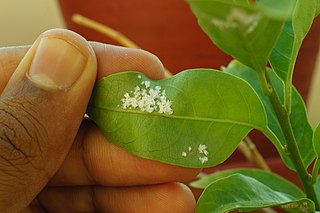
Flies are insects of the order Diptera, the name being derived from the Greek δι- di- "two", and πτερόν pteron "wing". Insects of this order use only a single pair of wings to fly, the hindwings having evolved into advanced mechanosensory organs known as halteres, which act as high-speed sensors of rotational movement and allow dipterans to perform advanced aerobatics. Diptera is a large order containing an estimated 1,000,000 species including horse-flies, crane flies, hoverflies, mosquitoes and others, although only about 125,000 species have been described.

A pollinator is an animal that moves pollen from the male anther of a flower to the female stigma of a flower. This helps to bring about fertilization of the ovules in the flower by the male gametes from the pollen grains.

Hoverflies, also called flower flies or syrphids, make up the insect family Syrphidae. As their common name suggests, they are often seen hovering or nectaring at flowers; the adults of many species feed mainly on nectar and pollen, while the larvae (maggots) eat a wide range of foods. In some species, the larvae are saprotrophs, eating decaying plant and animal matter in the soil or in ponds and streams. In other species, the larvae are insectivores and prey on aphids, thrips, and other plant-sucking insects.

A crane fly is any member of the dipteran superfamily Tipuloidea, which contains the living families Cylindrotomidae, Limoniidae, Pediciidae and Tipulidae, as well as several extinct families. "Winter crane flies", members of the family Trichoceridae, are sufficiently different from the typical crane flies of Tipuloidea to be excluded from the superfamily Tipuloidea, and are placed as their sister group within Tipulomorpha.

Woolly aphids are sap-sucking insects that produce a filamentous waxy white covering which resembles cotton or wool. The adults are winged and move to new locations where they lay egg masses. The nymphs often form large cottony masses on twigs, for protection from predators.

The Tephritidae are one of two fly families referred to as fruit flies, the other family being the Drosophilidae. The family Tephritidae does not include the biological model organisms of the genus Drosophila, which is often called the "common fruit fly". Nearly 5,000 described species of tephritid fruit fly are categorized in almost 500 genera of the Tephritidae. Description, recategorization, and genetic analyses are constantly changing the taxonomy of this family. To distinguish them from the Drosophilidae, the Tephritidae are sometimes called peacock flies, in reference to their elaborate and colorful markings. The name comes from the Greek τεφρος, tephros, meaning "ash grey". They are found in all the biogeographic realms.

The Asilidae are the robber fly family, also called assassin flies. They are powerfully built, bristly flies with a short, stout proboscis enclosing the sharp, sucking hypopharynx. The name "robber flies" reflects their expert predatory habits; they feed mainly or exclusively on other insects and, as a rule, they wait in ambush and catch their prey in flight.

The Tephritoidea are a superfamily of flies. It has over 7,800 species, the majority of them in family Tephritidae.

Carnoidea is a superfamily of Acalyptratae flies.

A leaf miner is any one of numerous species of insects in which the larval stage lives in, and eats, the leaf tissue of plants. The vast majority of leaf-mining insects are moths (Lepidoptera), sawflies, and flies (Diptera). Some beetles also exhibit this behavior.

Metrifonate (INN) or trichlorfon (USAN) is an irreversible organophosphate acetylcholinesterase inhibitor. It is a prodrug which is activated non-enzymatically into the active agent dichlorvos.
Babindella is a genus of flies in the family Dolichopodidae from Australia. It is the only genus in the subfamily Babindellinae, and is named after Babinda, the type locality. According to Grichanov (2018), there may be no basis for a separate subfamily for Babindella, which is considered to be related to several genera of Medeterinae such as Udzungwomyia.
Liancalomima is a genus of flies in the family Dolichopodidae.
Pseudoxanthochlorus is a genus of flies in the family Dolichopodidae. The genus contains only one species, Pseudoxanthochlorus micropygus, known from Yakovlevka, Primorsky Krai in Russia.

Achalcinae is a subfamily of flies in the family Dolichopodidae. It is an ancestral group close to Medeterinae and Sciapodinae.

The Chloropidae are a family of flies commonly known as frit flies or grass flies. About 2000 described species are in over 160 genera distributed worldwide. These are usually very small flies, yellow or black and appearing shiny due to the virtual absence of any hairs. The majority of the larvae are phytophagous, mainly on grasses, and can be major pests of cereals. However, parasitic and predatory species are known. A few species are kleptoparasites. Some species in the genera Hippelates and Siphunculina are called eye gnats or eye flies for their habit of being attracted to eyes. They feed on lachrymal secretions and other body fluids of various animals, including humans, and are of medical significance.

A gnat is any of many species of tiny flying insects in the dipterid suborder Nematocera, especially those in the families Mycetophilidae, Anisopodidae and Sciaridae. Most often they fly in large numbers, called clouds. "Gnat" is a loose descriptive category rather than a phylogenetic or other technical term, so there is no scientific consensus on what constitutes a gnat. Some entomologists consider only non-biting flies to be gnats. Certain universities and institutes also distinguish eye gnats: the Smithsonian Institution describes them as "non-biting flies, no bigger than a few grains of salt, ... attracted to fluids secreted by your eyes".
Afroparaclius is a genus of flies in the family Dolichopodidae. It includes two species from Africa formerly placed in Paracleius.
Igor Yakovlevich Grichanov is a Russian entomologist and ecologist. As a taxonomist, he specialised on Diptera notably Dolichopodidae. He joined the staff of the All-Russian Institute of Plant Protection in 1981. In 1990, he became the Head of the Laboratory of Phytosanitary Diagnostics and Forecasts. He wrote over 470 scientific papers (1979-2016). Не has described 26 new genera and over 400 new species of flies.
Pseudopelastoneurus is a genus of flies in the family Dolichopodidae. It includes two African species that were formerly classified in the genus Pelastoneurus.













